First Quarter Moon: Explained
The moon has fascinated humanity for thousands of years, and its various phases have played a significant role in shaping cultures, calendars, and even scientific observations. One such phase is the first quarter moon, also known as the half moon. In this blog post, we will explore what the first quarter moon is, how it occurs, and its significance.
Understanding the Lunar Cycle
Before delving into the first quarter moon, it is important to grasp the basics of the lunar cycle. The lunar cycle refers to the continuous orbit of the moon around the Earth, resulting in different lunar phases. This phenomenon takes approximately 29.5 days to complete, giving us familiar phases such as the full moon, new moon, and first quarter moon.
What is a First Quarter Moon?
The first quarter moon occurs when the moon is exactly halfway between the new moon and the full moon. From an observer’s perspective on Earth, the moon appears as a semicircle, with half of its surface illuminated by sunlight. Despite the name “quarter,” the moon is technically one-half or 50% illuminated during this phase.
When witnessing a first quarter moon, you can easily identify the line separating the illuminated and dark regions, known as the terminator. This line serves as the boundary between the regions of day and night on the moon’s surface.
What Causes the First Quarter Moon?
The first quarter moon occurs as a result of the relative positions of the Earth, moon, and sun. During this phase, the moon lies on a line perpendicular to the sun, with the Earth in between. This positioning causes sunlight to fall directly on one-half of the moon’s surface, creating the semicircular shape we observe from Earth.
It is important to note that the moon’s orbit is not a perfect circle but rather an ellipse. Therefore, the distance between the Earth and moon varies throughout the lunar cycle. However, the first quarter moon always occurs halfway between the new moon and full moon, irrespective of the moon’s distance from Earth.
Timeline of the First Quarter Moon
Understanding the timeline of the first quarter moon can provide further insights into its occurrence:
- New Moon: The lunar cycle begins with the new moon, where the moon is positioned directly between the Earth and the sun. At this stage, the moon is not visible from Earth as its illuminated side faces away from us.
- Waxing Crescent: Over the next few days, a small crescent of the moon becomes visible in the sky. This phase is known as the waxing crescent.
- First Quarter: Approximately a week after the new moon, the moon reaches the first quarter phase. This is when it appears as a half moon, with the right or left half illuminated depending on the hemisphere from which it is observed.
- Waxing Gibbous: Following the first quarter, the illuminated portion of the moon continues to grow. This phase is referred to as the waxing gibbous.
- Full Moon: Around two weeks after the new moon, the moon reaches its full moon phase. During this time, the entire face of the moon is illuminated, presenting a complete circle to observers on Earth.
The Significance of the First Quarter Moon
The first quarter moon holds scientific, cultural, and even agricultural significance:
Scientific Significance:
The study of the moon’s phases and their patterns contributes to our understanding of celestial mechanics. Observations of the first quarter moon, along with other lunar phases, help scientists refine their astronomical models of the Earth-moon-sun system and validate theories related to gravitational interactions.
Cultural Significance:
Throughout history, lunar phases have held cultural and symbolic significance. The first quarter moon, with its clear distinction between light and dark, has often been associated with themes of balance, beginnings, and progress. Many cultures weave lunar symbolism into their myths, calendars, and religious practices.
Agricultural Significance:
For centuries, the lunar cycle, including the first quarter moon, has influenced agricultural practices. Some farmers follow lunar calendars to determine the ideal timing for planting, harvesting, and other agricultural tasks. The first quarter moon is often seen as an opportune time for initiating growth and development in plants.
Conclusion
The first quarter moon, with its semicircular shape and half-illuminated appearance, serves as a notable phase within the lunar cycle. It carries scientific, cultural, and agricultural significance, contributing to our understanding of the universe and influencing various aspects of human civilization. So, the next time you gaze at the night sky and encounter the first quarter moon, take a moment to appreciate the natural wonders unfolding above.
Table of Contents
